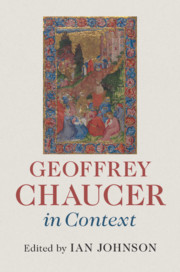Book contents
- Geoffrey Chaucer in Context
- Geoffrey Chaucer in Context
- Copyright page
- Contents
- Illustrations
- Contributors
- Abbreviations
- Introduction
- Part I Chaucer as Context
- Part II Books, Discourse and Traditions
- Part III Humans, the World and Beyond
- Part IV Culture, Learning and Disciplines
- Part V Political and Social Contexts
- Chapter 34 Dissent and Orthodoxy
- Chapter 35 The Church, Religion and Culture
- Chapter 36 England at Home and Abroad
- Chapter 37 Chaucer’s Borders
- Chapter 38 Rank and Social Orders
- Chapter 39 Chivalry
- Chapter 40 Chaucer and the Polity
- Chapter 41 The Economy
- Chapter 42 Towns, Villages and the Land
- Chapter 43 London’s Chaucer
- Chapter 44 Everyday Life
- Chapter 45 Household and Home
- Chapter 46 Marriage
- Chapter 47 Dress
- Part VI Chaucer Traditions
- Further Reading
- Index
Chapter 42 - Towns, Villages and the Land
from Part V - Political and Social Contexts
Published online by Cambridge University Press: 24 June 2019
- Geoffrey Chaucer in Context
- Geoffrey Chaucer in Context
- Copyright page
- Contents
- Illustrations
- Contributors
- Abbreviations
- Introduction
- Part I Chaucer as Context
- Part II Books, Discourse and Traditions
- Part III Humans, the World and Beyond
- Part IV Culture, Learning and Disciplines
- Part V Political and Social Contexts
- Chapter 34 Dissent and Orthodoxy
- Chapter 35 The Church, Religion and Culture
- Chapter 36 England at Home and Abroad
- Chapter 37 Chaucer’s Borders
- Chapter 38 Rank and Social Orders
- Chapter 39 Chivalry
- Chapter 40 Chaucer and the Polity
- Chapter 41 The Economy
- Chapter 42 Towns, Villages and the Land
- Chapter 43 London’s Chaucer
- Chapter 44 Everyday Life
- Chapter 45 Household and Home
- Chapter 46 Marriage
- Chapter 47 Dress
- Part VI Chaucer Traditions
- Further Reading
- Index
Summary
The Black Death first reduced England’s population by nearly one half then prevented demographic recovery. Volatility characterised the 1350s and 1360s, due to extreme weather conditions, poor harvests, contracting output, disrupted markets, labour shortages and a high turnover of people. Towns struggled to assimilate the influx of migrants. The availability of land on favourable terms, and of well-paid employment, greatly benefited the lower orders of society, but caused consternation to the ruling elite.The government responded with a wave of legislation to regulate labour mobility, prices and wages, so as to impose upon workers the discipline of manual labour deemed essential to the common profit. By the 1380s equilibrium had replaced the volatility. The economy had contracted, and shifted from arable production to pastoral and manufactured products. Towns were smaller, but their residents tended to be wealthier. The attitude of the authorities to labour had become more realistic and less idealistic, emphasising its noble qualities rather than denouncing its vices.
- Type
- Chapter
- Information
- Geoffrey Chaucer in Context , pp. 355 - 362Publisher: Cambridge University PressPrint publication year: 2019

